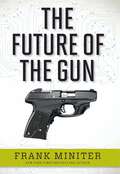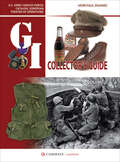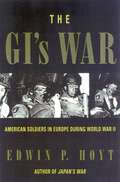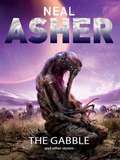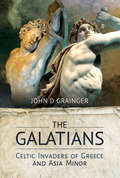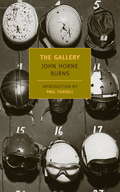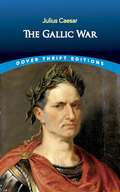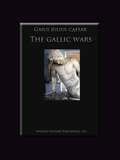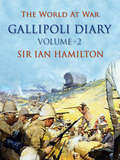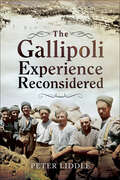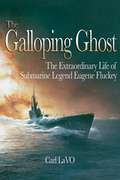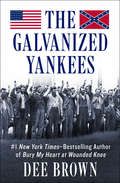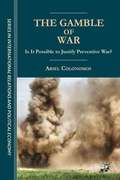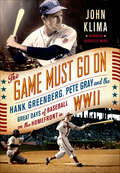- Table View
- List View
The Future of Warfare
by Bevin Alexander"With the planet no longer cleanly divided into 'us' and 'them,' leaders are distracted by a thousand conflicting claims and ambitions. We inhabit a much more disorderly world. Disputes within and between nations are frequently violent, divisive, and dangerous..." --from The Future of Warfare
The Future of the Gun
by Frank MiniterThe history of the American gun is intricately entwined with the history of America itself. Promising developments in gun technology could change not only America's future, but the future of the world. Unfortunately, the radical anti-gun lobby is standing between innovation and the American people. Bestselling author Frank Miniter details the amazing breakthroughs waiting to happen in gun technology that could make today's firearms exponentially safer and smarter-if the anti-gun lobby weren't halting progress in its tracks.In The Future of the Gun, you will learn:Why anti-gun groups often oppose gun safetyfeatures How guns-and gun education for young people-cut crime How federalism could save your gun rights New trends in gun technology that will make guns safer and more effectiveWhy most talk about "assault rifles" is bogus How military and civilian gun technology have always advanced in tandem-for the benefit of soldiers and private citizens What guns could look like in just a few yearsWant to know about the future of guns? There is no better place to start than here.ter, more powerful handguns at prices (when adjusted for inflation) the world has never seen.Taurus, a Brazilian gun maker, played with using 3D printers to make guns over a decade ago. A Texas manufacturer has now made Model 1911 pistols out of steel with 3D printers ... the genie is out of the bottle.
The Future of the Occupation of the Palestinian Territories after Gaza: Scenarios, Stakeholders and ‘Solutions’
by Erwin Van VeenThis open access book outlines four scenarios for the future of Israeli occupation of the Palestinian Territories as a broad canvas on which the interests, roles and perspectives of the key stakeholders involved in occupation are subsequently painted. An indirect result of 58 years of Israeli occupation of the Palestinian Territories, the Hamas attack on Israel of 7 October 2023 and the ensuing Israeli military campaign have greatly worsened Palestinian security in the short term, and Israeli security in the long term. Durable prospects for achieving reconciliation and peace are now shrouded in uncertainty, as political forces and views on both sides are likely to polarize and radicalize even further. October 7 and its aftermath have also introduced new uncertainties about the future nature of Israeli annexation and the modalities as well as extent of Palestinian resistance. Old frames have lost much of their validity, such as the Oslo agreements or even the logic underpinning security cooperation between the Palestinian Authority and the Israeli military. The book aims to improve our understanding of the post-October 7 context of occupation and the initiatives required to end it in the future. Ultimately, the book&’s intention is to shake up complacent policies and debates about the occupation of the Palestinian Territories by providing a more realistic basis for both reflection and action. While short-form analysis (e.g. blogs, essays and briefs) of October 7 and the ensuing events have proliferated, there has been little to no comprehensive analysis of the significance of these events for the future of occupation. Using the method of scenario planning to develop an analytical baseline, the added value of this book is that it offers a multi-dimensional consideration of this question both through the range of stakeholders it covers and the variety of its authors with respect to their research focus and perspective.
The Future of the U.S. Intercontinental Ballistic Missile Force
by S. Craig Moore Robert S. Leonard Glenn Buchan Lauren Caston Christopher A. Mouton Chad J. R. Ohlandt Raymond E. ConleyThe authors assess alternatives for a next-generation intercontinental ballistic missile (ICBM) across a broad set of potential characteristics and situations. They use the current Minuteman III as a baseline to develop a framework to characterize alternative classes of ICBMs, assess the survivability and effectiveness of possible alternatives, and weigh those alternatives against their cost.
The Führer’s Prophecy (The Reich Trilogy)
by Brian KleinJanuary, 1939Adolf Hitler makes an infamous speech at the Reichstag threatening 'the annihilation of the Jewish race in Europe'. This vile public proclamation is seized upon by his fanatical supporters who christen it 'The Führer's Prophecy'.November, 1943A sinister plot hatched inside Block 10 of the notorious Auschwitz deathcamp is known only to a handful of Nazis as Operation Gesamtkunstwerk. It's a plan originated by Hitler, Himmler and Mengele and now, almost eighty years later, it's finally ready to be actioned by the direct descendants of the Führer.April, 2022As the world emerges from the Covid pandemic, an encrypted zoom call involving five participants, based across four continents, approves a plan that could have unimaginable consequences for the State of Israel. Chief Inspector Nicolas Vargas of the Buenos Aires Police Department and Lieutenant Troy Hembury of the LAPD join forces with Lea Katz, an elite Mossad agent, in a race against time to try and prevent the unthinkable consequences of Operation Gesamtkunstwerk.
The Führer’s Prophecy (The Reich Trilogy)
by Brian KleinJanuary, 1939Adolf Hitler makes an infamous speech at the Reichstag threatening 'the annihilation of the Jewish race in Europe'. This vile public proclamation is seized upon by his fanatical supporters who christen it 'The Führer's Prophecy'.November, 1943A sinister plot hatched inside Block 10 of the notorious Auschwitz deathcamp is known only to a handful of Nazis as Operation Gesamtkunstwerk. It's a plan originated by Hitler, Himmler and Mengele and now, almost eighty years later, it's finally ready to be actioned by the direct descendants of the Führer.April, 2022As the world emerges from the Covid pandemic, an encrypted zoom call involving five participants, based across four continents, approves a plan that could have unimaginable consequences for the State of Israel. Chief Inspector Nicolas Vargas of the Buenos Aires Police Department and Lieutenant Troy Hembury of the LAPD join forces with Lea Katz, an elite Mossad agent, in a race against time to try and prevent the unthinkable consequences of Operation Gesamtkunstwerk.
The G.I. Collector's Guide: U.S. Army Service Forces Catalog, European Theater of Operations (G. I. Collector's Guide Ser. #1)
by Henri-Paul EnjamesIn World War II, the U.S. Army not only supplied its soldiers with the most modern equipment and uniforms, suitable for any combat situation, but went as far as providing them with their favorite drinks or candy bars, and seemingly anything else they might require. This comprehensive reference book brings together all the equipment issued to American soldiers in the European Theater of Operations, 1943–45. Each item is presented with its catalog numbers, described in detail and fully depicted in photographs, including close-ups of the labels to aid identification of items. Graphics and diagrams offer additional information and context. There are chapters on everything from uniform, insignia, and small arms issued to the individual, through crew-served weapons, rations, tents, to sports and recreation equipment. There is full coverage of the specialist items issued to Airborne, Armored, and Mountain troops, engineers, signallers, Military Police, medics, chaplains and female personnel. From the chewing gum included in K rations through to artillery-laying equipment, mess trays to portable altars and field harmoniums, this photographic reference gives a unique insight into the world of the U.S. Army in World War II. As a complete catalog with high-quality photographs, this book is invaluable to both family historians researching grandpa's kit found in the attic and to collectors in their quest to find authentic items among the reproductions that flood the modern market.
The G.I. Collector's Guide: Volume 2 (G. I. Collector's Guide Ser. #2)
by Henri-Paul EnjamesIn World War II, the U.S. Army not only supplied its soldiers with the most modern equipment and uniforms, suitable for any combat situation, but went as far as providing them with their favorite drinks or candy bars, and seemingly anything else they might require. This comprehensive reference book brings together all the equipment issued to American soldiers in the European Theater of Operations, 1943–45. Each item is presented with its catalog numbers, described in detail and fully depicted in photographs, including close-ups of the labels to aid identification of items. Graphics and diagrams offer additional information and context. This second volume of the G.I. Collector's Guide is fully revised with the addition of sections including personal equipment, trophies and souvenirs, the wartime draft and Stateside training, and the life of POWs in German camps. More than one thousand new artifacts with detailed captions are featured in this completely revised new work. Expert Henri-Paul Enjames describes all variations of uniform, insignia, badges, weapons, and equipment in detail. As a complete catalog with high-quality photographs, this book is invaluable to both family historians researching grandpa's kit found in the attic and to collectors in their quest to find authentic items among the reproductions that flood the modern market.
The GI's War: American Soldiers in Europe During World War II
by Edwin P. HoytThe GI's War contains eyewitness accounts from ordinary young men, farm hands and factory workers, who had war thrust upon them and in the process became veteran soldiers. Their unsparing narratives, presented in their own words, capture the many emotions evoked by war. GIs and their commanding officers speak freely, and movingly, of becoming soldiers, of enduring the ordeals of the various campaigns, and of fightling for their lives and their country. Vividly personal and compelling, this book puts the reader on the front lines.
The Gabble and Other Stories
by Neal AsherIn the eight years since his first full-length novel Gridlinked was published by Pan Macmillan, Neal Asher has firmly established himself as one of the leading British writers of Science Fiction, and his novels are now translated in many languages. Most of his stories are set in a galactic future-scape called &‘The Polity&’, and with this collection of marvellously inventive and action-packed short stories, he takes us further into the manifold diversities of that amazing universe. No one does monsters better than Neal Asher, so be prepared to revisit the lives and lifestyles of such favourites as the gabbleduck and the hooder, to savour alien poisons, the walking dead, the Sea of Death, and the putrefactor symbiont.
The Gabinian Affair (The Gaius Marius Chronicles #1)
by Ray GleasonA retired Roman soldier looks back on his early life and battlefield adventures fighting under Julius Caesar in this gripping fictional memoir. The Gabinian Affair is a memoir written by a retired Roman soldier, Gaius Marius Insubrecus, who served Caesar during his wars in Gaul. As a youth, Insubrecus is caught between two worlds: the heroic myths of his people, the Gahâél, and the harsh realities of their conqueror, Rome. Insubrecus tries to escape assassins sent after him from Rome by hiding in the Roman army, right at the time that the new governor, Gaius Julius Caesar, launches his legions into Gaul to stop an invasion by a fierce and ruthless tribe called the Helvetii. Insubrecus is plunged into a world of violence, intrigue and betrayal, as he tries to serve his new patron, Caesar, and to stay alive, while pursued by Roman cutthroats and Gallic warriors.
The Gadget
by Paul ZindelNear the end of World War II, scientists in Los Alamos, New Mexico, are working on a project that will alter the fate of the world. Thirteen-year-old Stephen Orr is living at a top secret military base with his father who is building the atomic bomb.
The Galatians: Celtic Invaders of Greece and Asia Minor
by John D. GraingerA historian of the ancient world examines the epic rise and fall of the Celtic tribes who invaded the Mediterranean and lands further east.The eastern Celtic tribes, known to the Greeks as Galatians, exploited the waning of Macedonian power after Alexander the Great’s death to launch increasingly ambitious raids and expeditions into the Balkans. In 279 BC they launched a major invasion, defeating and beheading the Macedonian king, Ptolemy Keraunos, before sacking the Greeks’ most sacred oracle at Delphi. Eventually forced to withdraw northwards, they were defeated by Antigonus Gonatus at Lysimachia in 277 BC but remained a threat.A large Galatian contingent was invited to cross to Asia to intervene in a war in Bithynia but they went on to seize much of central Anatolia for themselves, founding the state of Galatia. They remained a force in the region and their warriors served as mercenaries in many armies throughout the eastern Mediterranean. In this authoritative history, John Grainger explores the fortunes of these eastern Celts down to their eventual subjugation by the Romans, Galatia becoming a Roman province in 30 BC.
The Gallant Hood
by John Percy DyerJohn Bell Hood was a career soldier, the commander of the Texas Brigade, a staunch supporter of the Confederacy, serving Robert E. Lee and Jefferson Davis. His military history embraced both incredible success and dismal failure as he moved from the traditions of West Point to lead the ragged Confederate army. Hood sacrificed both his left arm and his right leg to the cause of Southern independence. At Sharpsburg and Gettysburg he was lauded as a brilliant officer and admired by the Southern belles who had heard of his unparalleled reputation for bravery on the battlefield.The Gallant Hood provides the reader with a sharp and affecting portrait of a man who helped to shape American history. It is the story of a warrior who would not give up his dream of an independent Southern nation no matter how heavy the consequences.—www.Goodreads.com
The Gallery
by Paul Fussell David Margolick John Horne Burns"The first book of real magnitude to come out of the last war." --John Dos Passos John Horne Burns brought The Gallery back from World War II, and on publication in 1947 it became a critically-acclaimed bestseller. However, Burns's early death at the age of 36 led to the subsequent neglect of this searching book, which captures the shock the war dealt to the preconceptions and ideals of the victorious Americans. Set in occupied Naples in 1944, The Gallery takes its name from the Galleria Umberto, a bombed-out arcade where everybody in town comes together in pursuit of food, drink, sex, money, and oblivion. A daring and enduring novel--one of the first to look directly at gay life in the military--The Gallery poignantly conveys the mixed feelings of the men and women who fought the war that made America a superpower.
The Gallic War: Commentaries Of Julius Caesar (hardcover) (Dover Thrift Editions)
by Julius Caesar H. J. EdwardsThe only chronicle by an ancient general of his own campaigns, this historical treasure is also a work of profound literary merit. Julius Caesar's fascinating account of his conquests offers a trove of priceless details about the cultures of Gaul, Germany, and Britain during the First century B.C.--and of the great man himself.Despite his extensive background in politics, Caesar expresses himself without hiding behind rhetoric, in an uncluttered, factual style. Vigorous, direct, and eloquent, his accounts resemble memoirs or historical outlines rather than a formal histories. His notes on cultural matters, although secondary to his attention to military affairs, offer the era's most complete picture of the settings and personalities among Celtic and German tribes. This excellent translation offers several helpful features.
The Gallic Wars
by Vincent W Rospond Gaius Julius CaesarThe most powerful army of its time is faced with insurgent attacks and revolts on the borders of their lands. A celebrated general proceeds to crush it and in the process makes a name for himself as a military commander. This is the history of the Gallic Wars written by the Roman commander, Gaius Julius Caesar, in which he explains how and why he committed Rome to this battle. This latest edition of an ancient classic in edited and annotated to explain the politics and armies of all combatants.
The Gallipoli Campaign: The Turkish Perspective (Routledge Studies in First World War History)
by Robert Johnson Metin GürcanThe war against the Ottomans, on Gallipoli, in Palestine and in Mesopotamia was a major enterprise for the Allies with important long-term geo-political consequences. The absence of a Turkish perspective, written in English, represents a huge gap in the historiography of the First World War. This timely collection of wide-ranging essays on the campaign, drawing on Turkish sources and written by experts in the field, addresses this gap. Scholars employ archival documents from the Turkish General Staff, diaries and letters of Turkish soldiers, Ottoman journals and newspapers published during the campaign, and recent academic literature by Turkish scholars to reveal a different perspective on the campaign, which should breathe new life into English-language historiography on this crucial series of events.
The Gallipoli Diary Volume 2 (The World At War)
by Ian HamiltonExcerpt: "11th July, 1915. Worked in my office from early morning till 12.45. The whole scheme for to-morrow's attack is cut and dried, according to our cloth: time tables fixed and every round counted. Freddy Stopford and his Staff turned up from Mudros. Stopford in very good form. The first thing he did was to deliver himself of a personal message from Lord K. He (Stopford) wrote it down, in the ante-room, the moment he left the presence and I may take it as being as good as verbatim. Here it is:— "Lord Kitchener told me to tell you he had no wish to interfere with the man on the spot, but from closely watching our actions here, as well as those of General French in Flanders, he is certain that the only way to make a real success of an attack is by surprise. Also, that when the surprise ceases to be operative, in so far that the advance is checked and the enemy begin to collect from all sides to oppose the attackers, then, perseverance[Pg 2] becomes merely a useless waste of life. In every attack there seems to be a moment when success is in the assailant's grasp. Both the French and ourselves at Arras and Neuve Chapelle lost the opportunity." Well said! K. has made Stopford bring me in his pocket the very text for what I wanted to say to him. Only my grumbling thoughts find expression by my pen but I have plenty of others and my heart has its warm corner for K. whenever he cares to come in."
The Gallipoli Experience Reconsidered: In 1915 and in retrospect
by Peter LiddleThe Gallipoli Campaign is generally viewed as a disastrous failure of the First World War, inadequately redeemed by the heroism of the soldiers and sailors who were involved in the fighting. But before the first landings were made, the concept of a strike at the Dardanelles seemed to offer a short cut to victory in a war without prospect of end. The venture, and what was required of the men undertaking it who were enduring heavy casualties, eminently deserve reconsideration in the centenary year of the campaign. What fuelled and what drained morale during the eight months of extraordinary human endeavour? A balanced evaluation of the Gallipoli gamble, and of the political and military leadership, are the challenging tasks which Peter Liddle sets himself in his new study of the campaign and the experience of the men who served in it.
The Galloping Ghost
by Carl P. LavoEugene Fluckey was one of the great naval heroes of World War II. His exploits as captain of the submarine USS Barb revolutionized undersea warfare and laid the groundwork for a nuclear-powered ballistic missile submarine fleet. He retired as a rear admiral and was awarded numerous presidential, congressional, and military honors, including the Medal of Honor and four Navy Crosses. In the war against Japan, Fluckey fired the first ballistic missiles from a submarine, sank more tonnage than any other U.S. submarine skipper, including an aircraft carrier, a cruiser, a destroyer, and blew up a train after landing submariners-turned-saboteurs on mainland Japan in 1945. Here is the legendary submariner's story, told with the exclusive access to Fluckey's personal papers and based on interviews with him, his family, Barb shipmates, official Navy documents, and the recollections of his contemporaries.
The Galvanized Yankees: Grierson's Raid, The Bold Cavaliers, And The Galvanized Yankees
by Dee BrownThe awe-inspiring true story of a group of Confederate soldiers who served in the Union ArmyHistorian Dee Brown uncovers an exciting episode in American history: During the Civil War, a group of Confederate soldiers opted to assist the Union Army rather than endure the grim conditions of POW camps. Regiments containing former Confederates were not trusted to go into battle against their former comrades, and instead were sent to the West as "outpost guardians," where they performed frontier duties, including escorting supply trains, rebuilding telegraph lines, and quelling uprisings from regional American Indian tribes, which were sweeping across the Plains. This is an account of an extraordinary, though often overlooked, group of men who served in unexpected ways at a pivotal moment in the nation's history. This ebook features an illustrated biography of Dee Brown including rare photos from the author's personal collection.
The Gamble of War: Is It Possible to Justify Preventive War? (The Sciences Po Series in International Relations and Political Economy)
by Chris TurnerThis book analyzes the justification of preventive war in contemporary asymmetrical international relations. It focuses on the most crucial aspect of prevention: uncertainty. It builds a new framework where the role of luck—whether military, political, moral, or normative—is a corrective to the traditional approaches of the just war tradition.
The Gamble: General Petraeus and the American Military Adventure in Iraq
by Thomas E. RicksFiasco, Thomas E. Ricks's #1 New York Times bestseller, transformed the political dialogue on the war in Iraq--The Gamble is the next news breaking installment Thomas E. Ricks uses hundreds of hours of exclusive interviews with top officers in Iraq and extraordinary on-the-ground reportage to document the inside story of the Iraq War since late 2005 as only he can, examining the events that took place as the military was forced to reckon with itself, the surge was launched, and a very different war began. Since early 2007 a new military order has directed American strategy. Some top U.S. officials now in Iraq actually opposed the 2003 invasion, and almost all are severely critical of how the war was fought from then through 2006. At the core of the story is General David Petraeus, a military intellectual who has gathered around him an unprecedented number of officers with both combat experience and Ph.D.s. Underscoring his new and unorthodox approach, three of his key advisers are quirky foreigners--an Australian infantryman-turned- anthropologist, an antimilitary British woman who is an expert in the Middle East, and a Mennonite-educated Palestinian pacifist. The Gamble offers news-breaking account, revealing behind-the-scenes disagreements between top commanders. We learn that almost every single officer in the chain of command fought the surge. Many of Petraeus's closest advisers went to Iraq extremely pessimistic, doubting that the surge would have any effect, and his own boss was so skeptical that he dispatched an admiral to Baghdad in the summer of 2007 to come up with a strategy to replace Petraeus's. That same boss later flew to Iraq to try to talk Petraeus out of his planned congressional testimony. The Gamble examines the congressional hearings through the eyes of Petraeus and Ambassador Ryan Crocker, and their views of the questions posed by the 2008 presidential candidates. For Petraeus, prevailing in Iraq means extending the war. Thomas E. Ricks concludes that the war is likely to last another five to ten years--and that that outcome is a best case scenario. His stunning conclusion, stated in the last line of the book, is that "the events for which the Iraq war will be remembered by us and by the world have not yet happened."
The Game Must Go On: Hank Greenberg, Pete Gray and the Great Days of Baseball on the Home Front in WWII
by John KlimaThe Game Must Go On offers a compelling and action packed story on how WWII changed American baseball, and how baseball helped to win the war.On December 7, 1941, as the battleships of Pearl Harbor smoldered, one of the most powerful athletes in America, Detroit Tigers MVP Hank Greenberg, made a tumultuous decision-to leave the baseball field for the field of war.His decision left baseball's place during the war uncertain as more and more ballplayers, famous and unknown alike, put off their careers to go into the fight. President Roosevelt was faced with a difficult decision: stop all of professional baseball for the good of the victory, but, in doing so, risk losing a vital part of morale. He decided that, whatever it took, THE GAME MUST GO ON.This is the story of American baseball history during World War II-of both the players who left to join the war and of the ones who struggled to keep the game alive on the home front. Taking the place of the big shots turned soldiers, sailors, and combat pilots were misfit replacement players. While Greenberg represented the player who served, Pete Gray symbolized the player who stayed. He was a one-armed outfielder who overcame insurmountable odds to become a professional athlete.John Klima drops us straight into 1941-1945. Culminating in the 1945 pennant race where Greenberg and Gray's paths memorably crossed, Klima shows us how World War II made the country come of age and took baseball with it. This is the story of how the games we play changed because of the battles we fought.

